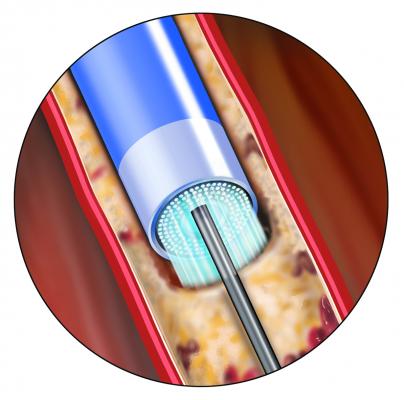
Study Supports Use of Laser Atherectomy for Peripheral In-Stent Restenosis
January 24, 2013 — The Spectranetics Corporation announced final results from the PATENT (Photo-Ablation using the TURBO-Booster(R) and Excimer Laser for In-Stent Restenosis Treatment) clinical study evaluating the safety and efficacy of the Spectranetics peripheral laser atherectomy catheters for the treatment of in-stent restenosis (ISR) in the femoropopliteal artery in the leg. ISR occurs as a result of narrowing of the artery in patients who have undergone stenting for the treatment of peripheral arterial disease (PAD). There is currently no U.S. Food and Drug Administration (FDA)-cleared or approved device to treat peripheral in-stent restenosis, which remains a major unsolved medical problem.
Ninety patients participated in this prospective, multi-center registry, which completed enrollment in December 2011 at five centers in Germany. The study evaluated extremely complex patients who had a previously failed stent procedure to address peripheral arterial disease.
Final results presented by Professor Thomas Zeller (Herz-Zentrum Bad Krozingen, Germany) at the Leipzig Interventional Course (LINC) 2013 in Leipzig, Germany, indicate 82 percent and 52 percent freedom from target lesion revascularization (TLR) at six and 12 months, respectively. Laser atherectomy demonstrated excellent midterm primary patency of 64 percent as compared to 37 percent with balloon angioplasty primary patency as published in previous clinical registries. This is a significant improvement considering the challenging nature of these patients.
In the PATENT Study, percent diameter stenosis was reduced from 87.1 percent to 7.5 percent post-laser atherectomy and balloon angioplasty as measured by the angiographic core lab. Procedural success rate, defined as achievement of less than or equal to 30 percent final residual restenosis, was 98.9 percent, and cumulative major adverse events (MAEs) were 2.2 percent from procedure through 30 days following the procedure. Patients saw significant and sustained improvement in ankle brachial index (ABI) and walking ability throughout the study. Laser atherectomy in ISR lesions also preserved excellent stent integrity throughout the duration of the study.
"The PATENT study demonstrates that with laser atherectomy, excellent acute results can be achieved and the underlying stent is not damaged. The patency and TLR rate seem to be significantly better compared to balloon-angioplasty, the current standard treatment of ISR," said Andrej Schmidt of Park Hospital, Leipzig Germany and principal investigator for PATENT.
Notably, the freedom from TLR rate within the PATENT study exceeds the targeted rate in the randomized, controlled EXCITE ISR (EXCImer Laser Randomized Controlled Study for Treatment of Femoropopliteal In-Stent Restenosis) trial, a landmark study currently underway in the United States, providing confidence in the EXCITE ISR trial design.
The EXCITE ISR trial will enroll up to 353 patients with chronic PAD associated with femoropopliteal in-stent restenosis at up to 35 centers in the United States. Patients are randomized in a 2:1 allocation to either laser atherectomy with adjunctive balloon angioplasty or balloon angioplasty alone. The study is designed to show superiority of laser atherectomy plus adjunctive balloon angioplasty for the primary efficacy endpoint of freedom from TLR.
"We are very encouraged by the PATENT results. This is a significant step forward in a compelling body of evidence that proves the safety and efficacy of laser atherectomy in treating in-stent restenosis. Successfully treating ISR represents an inflection point in our growth trajectory. This market is more than twice as large as the worldwide atherectomy market," said Scott Drake, CEO of Spectranetics.
The PATENT study population included patients with disease severity ranging from intermittent claudication to critical limb ischemia(Rutherford class 2-5). Lesions ranged from 1 cm to 25 cm with averagetotal lesion length of 12.3cm, and 93 percent were in the superficial femoralartery (SFA). Nearly 34 percent of patients had total occlusions. Fiftypercent of patients were diabetics, and 36 percent had previously been treated for in-stent restenosis using other therapies.
Spectranetics is also supporting a physician-initiated pilot study at four centers in Europe evaluating the use of laser atherectomy followed by a paclitaxel-coated angioplasty balloon (PTX PTA) compared with the use of PTX PTA alone in the treatment of in-stent lesions in above-the-knee arteries. Enrollment of 50 patients is expected to be completed in the first half of 2013. Spectranetics' support of the PHOTOPAC (Photoablation Followed by a Paclitaxel-Coated Balloon to Inhibit Restenosis in In-stent Femoropopliteal Obstructions) trial is in the form of an unrestricted research grant.
"The midterm patency with laser atherectomy for ISR lesions in the PATENT study is encouraging. We look forward to additional data on the combination of debulking with laser followed by local drug delivery," said Professor Thomas Zeller, a co-principal investigator of PHOTOPAC.
For more information: www.spectranetics.com


 April 24, 2024
April 24, 2024 








